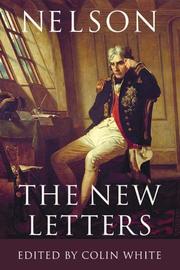| Listing 1 - 7 of 7 |
Sort by
|
Book
ISBN: 1616333863 Year: 2007 Publisher: Project Gutenberg
Abstract | Keywords | Export | Availability | Bookmark
 Loading...
Loading...Choose an application
- Reference Manager
- EndNote
- RefWorks (Direct export to RefWorks)
Trafalgar --- Battle of --- 1805 --- Juvenile fiction
Book
ISBN: 0853401624 Year: 1972 Publisher: London : Wayland,
Abstract | Keywords | Export | Availability | Bookmark
 Loading...
Loading...Choose an application
- Reference Manager
- EndNote
- RefWorks (Direct export to RefWorks)

ISBN: 9780230009004 023000900X Year: 2006 Publisher: Houndmills ; New York Palgrave Macmillan
Abstract | Keywords | Export | Availability | Bookmark
 Loading...
Loading...Choose an application
- Reference Manager
- EndNote
- RefWorks (Direct export to RefWorks)
Following the events and activity surrounding the bicentenary of Trafalgar and the death of Nelson, this volume acts both as a summary of what we have learned and a collection of some of the best scholarship on the battle itself and its context and legacy. It moves away from the figure of Nelson and brings new research from a range of disciplinary perspectives to bear on one of the most significant naval actions in the age of sail.
Napoleonic Wars, 1800-1815. --- Trafalgar, Battle of, 1805. --- Great Britain --- France --- History, Naval

ISBN: 1843831309 1843832992 1782044353 9786612080753 128208075X 1846154154 Year: 2005 Publisher: Woodbridge Rochester The Boydell Press in association with the National Maritime Museum and the Royal Naval Museum
Abstract | Keywords | Export | Availability | Bookmark
 Loading...
Loading...Choose an application
- Reference Manager
- EndNote
- RefWorks (Direct export to RefWorks)
"Presents around 500 of the most important letters uncovered during the course of the epic Nelson Letters project, a five-year search of archives round the world"--Provided by publisher.
Nelson, Horatio --- Correspondence --- Admirals --- Great Britain --- Nelson, Horatio Nelson, --- Nelʹson, Gorat︠s︡io, --- Nelson, Horacio, --- Nelson, --- 18th Century. --- Admirals. --- Battle of Trafalgar. --- British Navy. --- Compassion. --- Diplomatic Reports. --- Leadership. --- Letters. --- Love Letters. --- Naval Service. --- Nelson.
Book
ISBN: 1282620711 9786612620713 1846156378 1843833670 Year: 2008 Publisher: Woodbridge : Boydell,
Abstract | Keywords | Export | Availability | Bookmark
 Loading...
Loading...Choose an application
- Reference Manager
- EndNote
- RefWorks (Direct export to RefWorks)
Our understanding of warfare at sea in the eighteenth century has always been divorced from the practical realities of fighting at sea under sail; our knowledge of tactics is largely based upon the ideas of contemporary theorists [rather than practitioners] who knew little of the realities of sailing warfare, and our knowledge of command is similarly flawed. In this book the author presents new evidence from contemporary sources that overturns many old assumptions and introduces a host of new ideas. In a series of thematic chapters, following the rough chronology of a sea fight from initial contact to damage repair, the author offers a dramatic interpretation of fighting at sea in the eighteenth century, and explains in greater depth than ever before how and why sea battles (including Trafalgar) were won and lost in the great Age of Sail. He explains in detail how two ships or fleets identified each other to be enemies; how and why they manoeuvred for battle; how a commander communicated his ideas, and how and why his subordinates acted in the way that they did. SAM WILLIS has lectured at Bristol University and at the National Maritime Museum in Greenwich. He is also the author of 'Fighting Ships, 1750-1850' (Quercus).
Naval art and science --- Naval history --- History --- Naval tactics --- Naval warfare --- War, Maritime --- Tactics --- Baron Collingwood. --- Baron Hawke. --- Baron Rodney. --- Battle of Cape St Vincent. --- Battle of Havana. --- Battle of Minorca. --- Battle of Toulon. --- Battle of Trafalgar. --- Battle of Ushant. --- Battle of the Saints. --- Chesapeake Bay. --- Earl Howe. --- Lord Nelson. --- Royal Navy. --- Viscount Hood. --- cannon. --- maritime flags.
Book
ISBN: 0429054734 0429620039 042962218X 0367150417 1032178078 Year: 2019 Publisher: London ; New York, NY : Routledge/Taylor & Francis Group,
Abstract | Keywords | Export | Availability | Bookmark
 Loading...
Loading...Choose an application
- Reference Manager
- EndNote
- RefWorks (Direct export to RefWorks)
"Admiral Sir Philip Durham (1763-1845) was one of the most distinguished and colourful officers of the late Georgian Navy. His lucky and sometimes controversial career included surviving the sinking of HMS Royal George in 1782, making the first conquest of the tricolour flag in 1793 and the last in 1815, and having two enemy ships surrender to him at Trafalgar."--Provided by publisher.
Admirals --- Ship captains --- Admiral Sir John St Vincent. --- Admiral Sir Philip Durham. --- Admiral Sir Pulteney Malcolm. --- Captain Sir Thomas Staines. --- Leeward Islands. --- Lord Collingwood. --- Nelson. --- North American Station. --- Royal George. --- Sir Harry Neale. --- Sir Ralph Woodford. --- The Victorian Navy. --- Trafalgar. --- West indies. --- the Early Georgian Navy. --- the French Revolution. --- the Later Georgian Navy. --- Durham, Philip, --- Great Britain. --- Great Britain --- History --- History, Naval --- Officers
Book
ISBN: 1787858138 0691197318 9781787858138 9780691197319 9780691198330 0691198330 Year: 2019 Publisher: Princeton University Press
Abstract | Keywords | Export | Availability | Bookmark
 Loading...
Loading...Choose an application
- Reference Manager
- EndNote
- RefWorks (Direct export to RefWorks)
An authoritative, richly illustrated history of six centuries of global protest artThroughout history, artists and citizens have turned to protest art as a means of demonstrating social and political discontent. From the earliest broadsheets in the 1500s to engravings, photolithographs, prints, posters, murals, graffiti, and political cartoons, these endlessly inventive graphic forms have symbolized and spurred on power struggles, rebellions, spirited causes, and calls to arms. Spanning continents and centuries, Protest! presents a major new chronological look at protest graphics.Beginning in the Reformation, when printed visual matter was first produced in multiples, Liz McQuiston follows the iconic images that have accompanied movements and events around the world. She examines fine art and propaganda, including William Hogarth's Gin Lane, Thomas Nast's political caricatures, French and British comics, postcards from the women's suffrage movement, clothing of the 1960s counterculture, the anti-apartheid illustrated book How to Commit Suicide in South Africa, the "Silence=Death" emblem from the AIDS crisis, murals created during the Arab Spring, electronic graphics from Hong Kong's Umbrella Revolution, and the front cover of the magazine Charlie Hebdo. Providing a visual exploration both joyful and brutal, McQuiston discusses how graphics have been used to protest wars, call for the end to racial discrimination, demand freedom from tyranny, and satirize authority figures and regimes.From the French, Mexican, and Sandinista revolutions to the American civil rights movement, nuclear disarmament, and the Women's March of 2017, Protest! documents the integral role of the visual arts in passionate efforts for change.
Political art. --- Political posters --- Protest movements. --- ART / Art & Politics. --- Social movements --- Campaign posters --- Political collectibles --- Posters --- Activist art --- Protest art --- Resistance art --- Social art --- Art --- History. --- Political sociology --- Graphic arts --- graphic design --- history [discipline] --- revolutions --- political art --- graphic arts --- Activism. --- Adolf Hitler. --- Adolf. --- Advertising campaign. --- Advertising. --- Alamy. --- Alberto Korda. --- Anti-war movement. --- Apartheid. --- Art movement. --- Ben Shahn. --- Black people. --- Campaign for Nuclear Disarmament. --- Caricature. --- Cartoon. --- Cartoonist. --- Charlie Hebdo. --- Che Guevara. --- Civil disobedience. --- Civilization. --- Combatant. --- Communism. --- Dada. --- Defamation. --- Designer. --- Dictatorship. --- Editorial cartoon. --- El Lissitzky. --- Emblem. --- Environmentalism. --- Feminism (international relations). --- Feminism. --- Film poster. --- George Grosz. --- Global warming. --- Guerrilla Girls. --- Gulf War. --- Harper's Weekly. --- Headline. --- Iconography. --- Illustration. --- Illustrator. --- James Gillray. --- Je suis Charlie. --- Jesus Barraza. --- John Heartfield. --- LGBT. --- Le Charivari. --- Manifesto. --- March on Washington for Jobs and Freedom. --- Modernism. --- Mushroom cloud. --- National Association for the Advancement of Colored People. --- Nazi Germany. --- Nazi Party. --- Nazism. --- Newspaper. --- Nicaragua. --- Nuclear disarmament. --- Nuclear warfare. --- Nuclear weapon. --- Pamphlet. --- Pass laws. --- Photomontage. --- Political satire. --- Politician. --- Postcard. --- Poster. --- Power politics. --- Princeton University Press. --- Protest. --- Publication. --- Publishing. --- Racial segregation. --- Racism. --- Riot police. --- Sacco and Vanzetti. --- Satire. --- See Red Women's Workshop. --- Sexism. --- Simplicissimus. --- Soviet Union. --- Spanish Civil War. --- Special Relationship. --- Suffrage. --- Suffragette. --- Tear gas. --- Technology. --- Terrorism. --- The Quarto Group. --- Their Lives. --- Thomas Nast. --- Thomas Rowlandson. --- To This Day. --- Trade union. --- Trafalgar Square. --- Trayvon Martin. --- Tristan Tzara. --- Typography. --- Unemployment. --- communication design
| Listing 1 - 7 of 7 |
Sort by
|

 Search
Search Feedback
Feedback About UniCat
About UniCat  Help
Help News
News